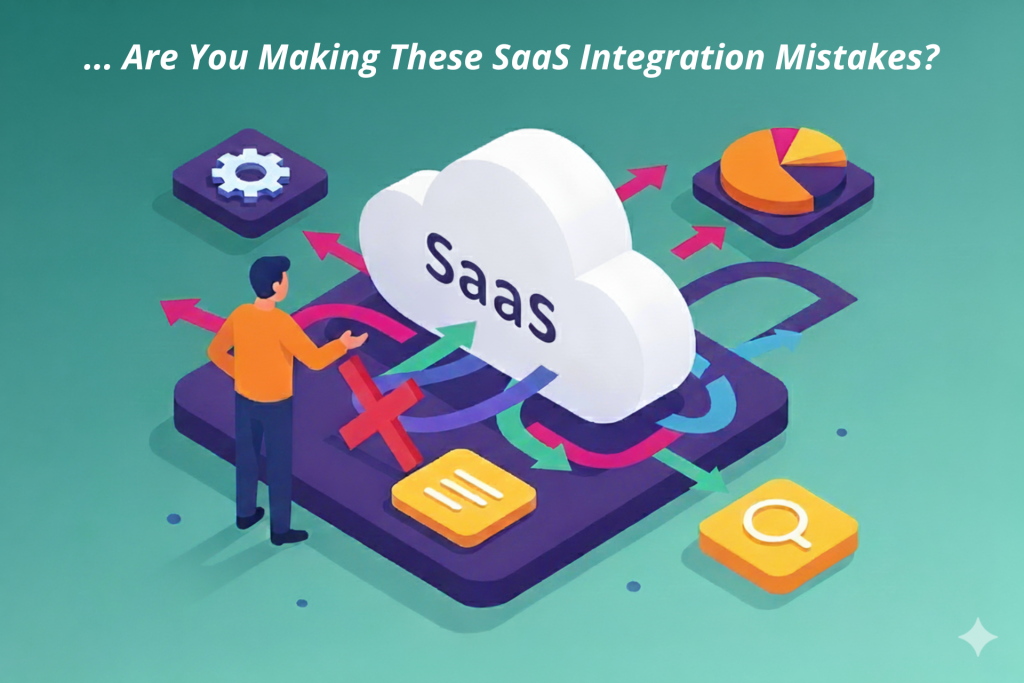
In my last two articles, we explored why SaaS integration matters and how to begin your integration journey with clarity and confidence. If those steps helped you understand the “why” and the “where to start”, this article focuses on something equally important: what to avoid along the way.
Because regardless of company size—whether it’s a small business with five employees or a mid-sized organization with several departments—most teams fall into the same five traps when they begin integrating SaaS tools. And the truth is, these mistakes are more common than most leaders realize.
The good news? Once you know what they are, they’re not only easy to avoid—they can save you time, money, and frustration across your entire business.
1. Trying to Integrate Everything at Once
Many businesses get excited about integration and decide to connect multiple tools simultaneously. The intention is good: “Let’s automate everything and eliminate all manual work.” But without a roadmap, this quickly leads to confusion, errors, and wasted hours.
For example, a small marketing agency with 12 employees tried to integrate their CRM, email platform, invoicing tool, and project tracker all in the same week. The result? Bugs, data conflicts, and a team that didn’t trust the new processes. They eventually paused everything to start over—this time with just one workflow.
How to Avoid It:
Start with one high-impact workflow. Solve one problem well, show the result, and build momentum. Integration is a journey—small wins create trust and adoption.
2. Choosing Technology Before Understanding Processes
Many leaders make this mistake: they select an integration platform first (Zapier, Make, Workato, etc.) and only then try to force their processes to match the tool. This often leads to unnecessary complexity or the wrong solution altogether.
In a medium-sized company with 85 employees, the IT team chose an integration tool before talking to Sales or Operations. They later discovered that the tool didn’t support the data logic needed for their specific workflow. The result? Rework, extra cost, and frustrated users.
How to Avoid It:
Always begin by mapping your current processes—not the tools. Ask your team:
- Where do we lose time today?
- Where do mistakes happen?
- Where are we double-entering data?
Once the workflow is clear, then choose the technology that best supports it.
3. Ignoring the People Side of Integration
Integration is not just a technical project—it’s a change management project. Even the best-designed workflows will fail if people don’t understand them or don’t feel included.
A common scenario: a business owner sets up automation between the CRM and accounting software, but doesn’t train the admin team on how data flows. When something breaks or data doesn’t match, the team panics and stops using the system. The automation gets blamed, not the lack of communication.
How to Avoid It:
- Involve end-users early.
- Explain the “why”, not just the “how”.
- Provide short, simple training.
- Ask for feedback after the first week and adjust if needed.
When people feel included, they support the change rather than resist it.
4. Not Monitoring and Assuming “Set and Forget”
Integration is powerful, but it’s not magic and it’s not a one-time job. Many teams launch an integration and assume it will run forever without supervision. But SaaS tools change, APIs update, and business processes evolve.
A 40-person e-commerce company integrated their order system with inventory and shipping tools. It worked perfectly for three months—until the shipping platform changed a field name in its API. Orders stopped syncing, and no one noticed for two days. Customer complaints exploded.
How to Avoid It:
Assign a lightweight monitoring routine. It doesn’t need to be complex:
- Weekly check for sync status
- Alerts for failed automation runs
- A simple log or dashboard to track integrations
Treat integrations like a digital employee—check in occasionally to make sure they’re doing their job.
5. Overlooking Data Quality and Security
Integrations move data from one system to another. If the data going in is messy, duplicated, or outdated, the integration will simply spread the problem faster. And if data access isn’t controlled, you expose your business to risk.
A medium-sized HR firm integrated candidate data across HR tools, but employees were exporting data into spreadsheets, then uploading it manually. Data became inconsistent, and access was not tracked—raising compliance concerns.
How to Avoid It:
- Clean and validate data before integrating
- Define who has access to connected tools
- Apply basic security practices (permissions, roles, logging)
- Reduce manual exports—especially of sensitive data
Good data hygiene makes integrations more reliable and scalable.
Final Thoughts
SaaS integration is one of the most impactful steps a modern business can take to improve efficiency, reduce errors, and create a more connected operation. But like any strategic initiative, success depends on starting with the right mindset and avoiding avoidable mistakes.
If you take one thing from this article, let it be this:
Start small, stay curious, listen to your team, and evolve as you grow.
Your integration journey doesn’t have to be overwhelming. By focusing on clarity, communication, and continuous improvement, you set the foundation for a stronger, smarter, and more scalable business.
In my next article, I’ll share simple real-life SaaS integration examples you can apply—whether you’re a small business or a growing organization.
